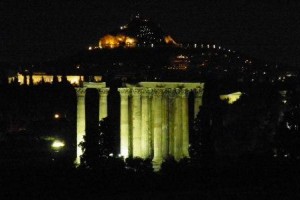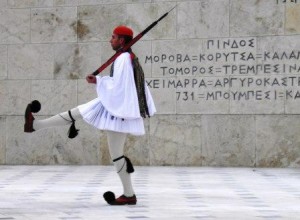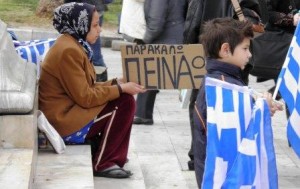BEFORE we went on our recent trip to Athens, our first for many years, we were warned by other expats about how frenetic the city has become. We were told about bag snatchers around the tourist hot-spots, and their techniques were described in glorious detail by at least one expat. So we practised a few karate manoeuvres the night before, in readiness, and left with a tiny bit of trepidation.
We were also told by expats that we’d be bonkers to drive to Athens and that it was better to take the coach instead from Kalamata bus station. But having driven to Athens now, we strongly disagree with the doomsayers. The motorway from Kalamata was very smooth and pristine (especially the new section from Kalamata to Tripoli) and other drivers were mostly very restrained, which hasn’t always been our experience in the Mani. There was however the odd driver trying to break the land speed record while talking on a mobile.
The drive through the outskirts of Athens was a bit tormenting, but the Royal Olympic Hotel, where we stayed, offers a very detailed map on its website www.royalolympic.com for driving right to the hotel, and out again, which was brilliant. Once you hit the slightly down-at-heel outskirts of Athens, the sight of thousands of apartment blocks stretching to infinity is also a bit tormenting.
But the city centre is great. It’s buzzy and clean. Okay, it is quite crowded and very modernised in parts. It’s not the wonderfully exotic Levantine hub it once was, but it has great appeal nevertheless.

Majestic sight: The floodlit Temple of Zeus as seen from the rooftop garden at the Royal Olympic Hotel
As did our stay at the centrally located Royal Olympic Hotel, which offered us the upgrade of the Athenian Panorama suite with an eye-watering view across the road to the Temple of Olympian Zeus. Who wouldn’t want to fall asleep every night to the sight of 15 mighty floodlit columns?
We only had three days in the capital, which wasn’t enough, and a repeat visit is on the cards. It is possible, however, to see some of the main sights in that time, including the new Acropolis Museum, the Acropolis itself and the Benaki Museum. We also had time to take in the Ancient Agora, which is a huge, lovely site, if slightly neglected in parts, in the shadow of the Acropolis.
The Agora was once the social and political heart of ancient Athens, with temples, sanctuaries, libraries and meeting places. However, it was a men-only hangout and it was here that Socrates, Plato and Demosthenes came to argue the toss and thrash out the beginnings of our Western civilisation. Hard to see any reminder of that now among the fallen columns, ruined temples and broken walkways. Only when the wind rustles the long grass among the ruins do you get a whisper of the past.
But it was here that we identified the best public service job in the world – the Agora guards. They sit all day among the trees on plastic chairs, camouflaged as tired sightseers in their everyday clothing, guarding the antiquities and making sure there’s no hanky-panky in the undergrowth.
One statue must give them particular grief. It’s a rather handsome but headless statue on a plinth of an Athenian thinker that must lure thousands of visitors for a look-here’s-my-head-on-a-Greek-statue photo opportunity, with the Acropolis looming in the distance for added creative appeal.
The day we were there we thought of doing exactly the same (well Jim did), but we were glad we didn’t try it. Some other wreckless soul was about to get his leg over the plinth when an Agora guard leapt out of her chair, sprinted over and admonished him loudly for the cultural barbarian he was and sent a few dozen tourists scattering for cover, including us.
Here’s our suggestions for other interesting sites, cafes, restaurants, and so forth, for anyone interested, and in no particular order:
1. The Benaki Museum on Vas. Sofias Avenue (www.benaki.gr) has one of the most eclectic and fabulous collections of Greek antiquities, icons, folk costumes, paintings. My favourite was the large collection of jewellery from antiquity to recent times. And the rooftop restaurant/café is very smart and seems to attract a bevy of well-heeled Athenian ladies and bon vivants. Not to be missed;
2. The old district of Monastiraki, with its flea market, tourist shops with tat we know and love, like those funny woollen slippers and cheesecloth shirts. And the old record/CD shops have great collections of out-of-date albums;
3. The Roof Garden restaurant on the top floor of the Royal Olympic Hotel is expensive but go up there just for a drink at the bar because the view, especially at night, of the Acropolis and the Temple of Zeus is stunning;
4. Visit the old fashioned grill taverna psistaria, the Ambrosia, with good food, generous portions and authentic atmosphere on Drakou St, off Syngrou Avenue (not far from the Acropolis Museum);
5. The Plaka. It isn’t what it used to be, Athenians told us. “The old neighbourhood is finished,” said one taverna owner. The ‘real’ people were moved on by the city’s bureaucrat planners to make way for the gentrification of the old Plaka houses, with their fabulous courtyards. I can’t comment on that but the area is still fascinating and full of tiny churches, small squares, and many fine restaurants. We ate at the Elaia in Erotokritou St, which is chic/traditional with good food and a nice atmosphere and a favourite apparently of film stars and other luminaries;
6. Melina’s café in Plaka, 22 Lissiou St, is worth a visit for its trendy bohemian chic and because it has the biggest collection of Melina Mercouri photos and memorabilia. Not because it was a favourite haunt of hers, the owner told us, but the collection was created to honour the life of this Greek icon. Zorbas Taverna, across the road, is also a nice venue (www.zorbasrestaurant-plaka.gr);
7. The Gazi area of Athens, near the ancient cemetery of Kerameikos, is also worth a visit. Gazi is a former industrial slum, now regenerated, with trendy bars, cafes, tavernas, but it’s a bit more edgy at night than the Plaka;
8. There seem to be very few city shops now selling folk arts – rugs, paintings, ceramics, jewellery etc, but the family-run Amorgos shop on Kordou St, Plaka, (www.amorgosart.gr) is a survivor, crammed with wonderful pieces. More museum than shop really;
9. The lovely 12th century church of Panayia Gorgoepikoos, which apparently means ‘Our Lady who Grants Requests Quickly’ is an oasis of calm in Mitropoleos Square, where you also find the Cathedral of Metropolis, which houses some of the sacred remains of Ayia Filothei, a saint who once help the city’s orphans;
10. The Korres shop, on Ivikou Street, Pangrati, for the full range of its natural toiletries and make-up.
Freedom or death
OUR last day in Athens was the day before the March 25th Celebration of Independence. The War of Independence against 400 years of Turkish rule lasted from 1821 to 1829 and is still celebrated in great style in Greece, with marches and various state events, and one of its great catch cries is “Victory or death”.
On the 24th there was a students’ march planned and altogether the city was gearing up for the next day’s events, with a huge police presence in the city and army and navy units milling around in front of the Presidential building. Here the famous Evzone guards were wearing their ceremonial white skirts, pompom shoes and gold embroidered waistcoats and doing their precision slow-motion changing of the guard.
There was a lot of bustle in the area and some took the opportunity to draw attention to various causes, personal or otherwise, like the woman in a headscarf sitting quietly in Syntagma Square begging, holding a simple piece of cardboard announcing in Greek that she was hungry.
If this had been Glasgow at 11am, she’d have been high on Buckfast tonic wine, sitting in a shop doorway, with probably a skinny mutt in tow, and loudly abusing passers-by. But at least the countless number of migrants who usually swarm Athens selling their fake Gucci bags and pirate CDs weren’t in evidence because of the number of police around.
Athens must have one of the highest concentrations of asylum seekers in Europe, as they come here via some of the islands off the coast of Turkey and then move on through Europe, often towards Britain, as we know. It’s one of the aggravations of this city, along with gypsy kids forced to beg at tables who will come back again and again and pester you until you give them something. It’s confronting, and sad, but it still seemed like a small problem compared to the fabulous cultural offerings that Athens has.
Spring delivers
THE turnaround between winter and spring is so much quicker in Greece than in Britain, of course. It’s lovely to see all the wintry thin trees and shrubs coming to life again. It’s hard to believe that the spindly branches of the mulberry trees that decorate our front garden will, in about six weeks, be thick and dripping with fat, red mulberries. The olive groves and hillsides are also carpeted in daisies, poppies, lilies and wild orchids. With the olive harvest complete there is still work going ahead clearing orchards of pruned branches, which are stripped and chopped for next winter’s firewood. In our village a priest with long beard and hair, blue cap and gown, regularly drives past on an orange tractor on the way to his farmlands to look after his other flocks.
Big Fat Athens Oddity
WE were pleased to see that in Athens motorbike riders wear helmets, as opposed to Kalamata, where mostly they don’t. Maybe it’s because of a higher police presence in the capital. But we were dismayed to see one helmeted rider who was fed up waiting for the red traffic lights to change on a major road. He mounted the pavement and roared along the busy footpath, weaving his way around startled pedestrians, before rejoining the road further along and speeding off. www.bigfatgreekodyssey.com
© Copyright of the authors 2011





